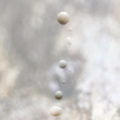Some of the sounds are from musical instruments, enjoying the long sustained energizing of strings, like a fragmented lingering cello, sometimes bowed, sometimes plucked. What I hear consistently through each track is a fascination for the drone concept, extended tones, often decorated by interesting and harmonious field sounds and counter tones.

Sculpted sound, extended tones and humming/vibrating/glowing with harmonics
Sintering or frittage is the process of compacting and forming a solid mass of material by heat or pressure without melting it to the point of liquefaction. Sintering is performed at high temperature and happens as part of a manufacturing process used with metals, ceramics, plastics, and other materials. The material produced by sintering is called sinter. The word sinter comes from the Middle High German sinter, a cognate of the English term cinder.
Each track is totally unique and explores new harmonious tonality within the extended tone drone format. Some of the sounds are from musical instruments, enjoying the long sustained energizing of strings, like a fragmented lingering cello, sometimes bowed, sometimes plucked. What I hear consistently through each track is a fascination for the drone concept, extended tones, often decorated by interesting and harmonious field sounds and counter tones. There are some loops in the mix. Loops are repeated bits of sound, which can provoke insanity or can be used just for laughs, for the album Sinter the effect is quite different, very much blended into the craft of sound design. The name “loops” comes from forming pieces of magnetic audio tape into circles, when the results are played on a tape machine the results are immediate, in the form of repetition without mercy. On Sinter, the loops are all wonderfully harmonious, achieving the final effect of an engaging balanced and blended mixture.
Like a moment spent out of doors at night, in the distance I hear a glowing loop of perhaps a sigh or a fragment of a moment of a song sung, too quick to know, in a waterfall of short bits of sounds. Now I hear a guitar being gently energized physically, gaining a heartbeat rhythm, “Fern” (4:01) changes into a piano and I hear some unknown activity making bumps and noises, maybe a fire crackles and there are various sounds of water at the beach, with sea birds, a faster machine fades behind, “Lithh” (1:21) has what I take to be the sound of a tennis game beat to start, it moves into electronic buzzes and quick studies, now the melody almost comes into focus. Things keep flowing into new shapes. The balls return and volley. “Konstant” (4:24) starts with what I take to be a skipping record, something that once was a constant part of the home listening landscape. The gently repeating sound of the ping of sonar in the Navy movies, wandering lusciously into increasing throbbing hums and what I might call question tones (ascending, as if representing an interrogative melody), short and neat. Reverberating cables of sound, throbbing reverberations, “Decay” (1:24) is (to my ears) about how long the reverberations hold on. Some of the reverb beats might not be dead yet.
Contrasting intensity of brightness within velvet darkness ::
The next track comes slowly turning the contrasting intensity of brightness within velvet darkness, “Glitter” (1:31) dabbles in more building tension, eventually becoming a slow silky walking conga beat, I hear what might be a humming and throbbing organ and skilled hand drums. Slow questions. The twin track, “Glimmer” (2:11), is surely measured differently, there is more forward stepping, the melody has an unexpected pattern, perhaps layers of vaporized colors in a breeze, and a quivering organ with extended reverberations, sort of a semi-melodic, all vibrato, parade up a mountain, slow and deliberate, long low tones that slowly build, very slowly. The title of the track “Muster” (6:10) makes me think of gathering together. Imagine my mirror in the morning, I am confused in the glowing post-darkness and troubled with all the new abrupt little bumps, the growing hum overtakes more and more of the possible details, and the cycle repeats, always adding increasing layers of metallic nanoparticles. Now I am wondering if perhaps this is the new nanoscience of mutual induction electronic ambient music. On the eighth track I hear electromagnetic forces that extend into the empty space around the functioning energy conductor, “Faraday” (2:22). Maybe there are some strange birds in there. Albert Einstein kept a picture of Faraday on his study wall. Although Michael Faraday (1791-1867) received little formal education, he was one of the most influential scientists in history, his main discoveries include the principles underlying electromagnetic induction, diamagnetism and electrolysis. His inventions of electromagnetic rotary devices formed the foundation of electric motor technology, and it was largely due to his efforts that electricity became practical for use in technology. Sandemanian Faraday was also active in what would now be called environmental science, by 1855 he was investigating air pollution and fretting over the increasingly foul condition of the River Thames.
I hear what sounds like buzzing glass with chimes, I like these sounds of physical vibrations, and organ loops. “Sinter” (3:16) develops in throbbing pools of looping glowing summer sounds, possibly with horns, the glow overwhelms the details at times. I hear reverberating strings in slow motion and think of free energy. One Afrikaaner word for scale is “Skaal” (2:27), this track features a shift from free energy to something big moving slowly back and forth. Easy dreaming drifting humming. There is an expression, to turn, in German, “Wendung” (9:00). The sound to me moves in a turning motion, very slow circles, deep low foundations with ringing high tones that come and go, sort of like seaweed forms in a tidal pool, pushed by the moving water of the waves coming to shore. I love slow motion revolutions.
The last track starts off a little more harshly, “Oktaf” (2:22). Fun fact, OKTAL means octave in Indonesian. I hear a shimmering power, gently floating. Tricks with rainbows. Water drumming and rain completes the track.
There were physical vinyl and silver discs made, all sold out. Black LP (300 copies) / CD (200 copies) / Digital of course too.
Sinter is available on laaps. [Bandcamp]
Arovane is the recording name of German electronic music artist Uwe Zahn (born 1965 in Hameln, Germany). Arovane translates into English as “effect,” something fundamental to the nature and practice of music. For Arovane, that means following the inspiration of the romantic composers in their ethos of creating music that was “individualistic, emotional, dramatic and often programmatic.”
Arovane can possibly be compared to a blend between the robotic glitch sound of early Autechre and the expansive open synth-laden fields of Boards of Canada. Zahn and his music are often referred to as being melodically advanced.
Arovane’s sound has been characterized as ethereal, melodic, organic, warm and ambient yet technically involved with structured, often heavy, breakbeat and hip hop influenced beats. It is richly layered with synths and textured distortions and focuses more on generating a melancholy nostalgic feeling than four-on-the-floor dance beats. The tempos are midrange and Arovane has been labeled as IDM, having his album Tides listed in Pitchfork’s 50 Best IDM Albums of All Time.

























![Romanowitch :: A critical season substitute (glitch.cool) — [concise]](https://igloomag.com/wp/wp-content/uploads/2025/03/romanowitch-a-critical-season-substitute_tape_feat-75x75.jpg)

